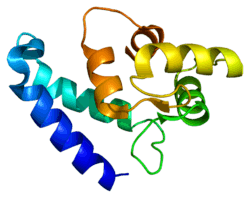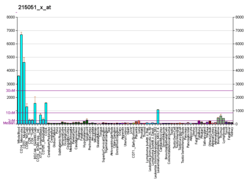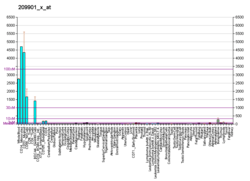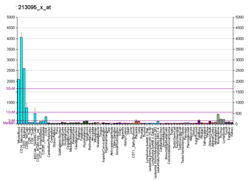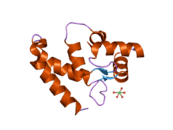Allograft inflammatory factor 1
Allograft inflammatory factor 1 (AIF-1) also known as ionized calcium-binding adapter molecule 1 (IBA1) is a protein that in humans is encoded by the AIF1 gene.[5][6]
Gene
The AIF1 gene is located within a segment of the major histocompatibility complex class III region. It has been shown that this gene is highly expressed in testis and spleen, but weakly expressed in brain, lung, and kidney. Among brain cells, the Iba1 gene was specifically expressed in microglia. Upon activation of microglia due to inflammation, expression of Iba1 is upregulated allowing the discrimination between surveiling and activated microglia.
Function
AIF1 is a protein that exists in the cytoplasm, and it is highly evolutionarily conserved. It is also possibly identical to three other proteins, Iba-2, MRF-1 (microglia response factor) and daintain. However complete functional profiles of all three proteins and how they overlap is unknown.[7] IBA1 is a 17-kDa EF hand protein that is specifically expressed in macrophages / microglia and is upregulated during the activation of these cells. Iba1 expression is up-regulated in microglia following nerve injury,[8] central nervous system ischemia, and several other brain diseases.
AIF1 was originally discovered in atherosclerotic lesions in a rat model of chronic allograft cardiac rejection. It was found to be upregulated in macrophages and neutrophils in response to the cytokine IFN-γ.[9] AIF1 expression has been seen to increase in vascular tissue in response to arterial injury, specifically it is found in activated vascular smooth muscle cells in response to IFN-γ, IL-1β, and T-cell conditioned media.[10] In vascular smooth muscle cells, activation is responsible for arterial thickening in allografts through over proliferation. AIF1 has been found to enhance growth and promote proliferation in vascular smooth muscle cells through deregulation of the cell cycle. It does this by shortening the cell cycle and altering the expression of cyclins.[11] Though histologically different, AIF1 has also been shown to promote the proliferation and activation of endothelial cells (EC). EC activation, leads to proliferation and migration of cells, which is involved in multiple normal vascular processes, such as atherosclerosis, angiogenesis, and wound healing. It is currently theorized that AIF1 works to control endothelial cell proliferation and migration through action in signal transduction pathways.[12] It has features of a cytoplasmic signaling protein, including several domains that allow for binding to multiprotein complexes, called PDZ domains.[13] In endothelial cells, AIF1 has been specifically shown to regulate vasculogenesis, including the formation of aortic sprouting and tube-like formations. AIF1 been shown to interact with kinase p44/42 and PAK1, two previously known signal transduction molecules, in regulating these processes. AIF1 also shows distinct differences in the pathways by which it regulates endothelial cells, macrophages, and vascular smooth muscle cells.[12]
Clinical significance
Allograft Inflammatory Factor 1 is found in activated macrophages. Activated macrophages are found in tissues with inflammation. AIF1 levels in healthy humans have been found to positively correlate with metabolic indicators, such as body mass index, triglycerides, and fasting plasma glucose levels. The excess of adipose tissue found in obese patients is found to cause chronic inflammation with an increase in the number of activated macrophages. Subsequently, AIF1 may be an accurate indicator of macrophage activation in the body.[14] There is also evidence that AIF1 could be a marker for diabetic nephropathy when detected in serum.[15] Since diabetic nephropathy is a consequence of long-term type 1 and type 2 diabetes, this consistent with evidence that AIF1 may be associated with other aspects of diabetes. It is found in activated macrophages in the pancreatic islets, and has been shown to decrease insulin secretion, while simultaneously impairing glucose elimination.[16]
References
- 1 2 3 ENSG00000235985, ENSG00000235588, ENSG00000234836, ENSG00000237727, ENSG00000204472 GRCh38: Ensembl release 89: ENSG00000206428, ENSG00000235985, ENSG00000235588, ENSG00000234836, ENSG00000237727, ENSG00000204472 - Ensembl, May 2017
- 1 2 3 GRCm38: Ensembl release 89: ENSMUSG00000024397 - Ensembl, May 2017
- ↑ "Human PubMed Reference:".
- ↑ "Mouse PubMed Reference:".
- ↑ Autieri MV (Dec 1996). "cDNA cloning of human allograft inflammatory factor-1: tissue distribution, cytokine induction, and mRNA expression in injured rat carotid arteries". Biochem Biophys Res Commun. 228 (1): 29–37. doi:10.1006/bbrc.1996.1612. PMID 8912632.
- ↑ "Entrez Gene: AIF1 allograft inflammatory factor 1".
- ↑ Deininger MH, Meyermann R, Schluesener HJ (March 2002). "The allograft inflammatory factor-1 family of proteins". FEBS Lett. 514 (2–3): 115–21. doi:10.1016/S0014-5793(02)02430-4. PMID 11943136.
- ↑ Ito D, Imai Y, Ohsawa K, Nakajima K, Fukuuchi Y, Kohsaka S (June 1998). "Microglia-specific localisation of a novel calcium binding protein, Iba1". Brain Res. Mol. Brain Res. 57 (1): 1–9. doi:10.1016/s0169-328x(98)00040-0. PMID 9630473.
- ↑ Utans U, Arceci RJ, Yamashita Y, Russell ME (June 1995). "Cloning and characterization of allograft inflammatory factor-1: a novel macrophage factor identified in rat cardiac allografts with chronic rejection". J. Clin. Invest. 95 (6): 2954–62. doi:10.1172/JCI118003. PMC 295984. PMID 7769138.
- ↑ Autieri MV, Carbone C, Mu A (July 2000). "Expression of allograft inflammatory factor-1 is a marker of activated human vascular smooth muscle cells and arterial injury". Arterioscler. Thromb. Vasc. Biol. 20 (7): 1737–44. doi:10.1161/01.ATV.20.7.1737. PMID 10894811.
- ↑ Autieri MV, Carbone CM (September 2001). "Overexpression of allograft inflammatory factor-1 promotes proliferation of vascular smooth muscle cells by cell cycle deregulation". Arterioscler. Thromb. Vasc. Biol. 21 (9): 1421–6. doi:10.1161/hq0901.095566. PMID 11557666.
- 1 2 Tian Y, Jain S, Kelemen SE, Autieri MV (February 2009). "AIF-1 expression regulates endothelial cell activation, signal transduction, and vasculogenesis". Am. J. Physiol., Cell Physiol. 296 (2): C256–66. doi:10.1152/ajpcell.00325.2008. PMC 2643850. PMID 18787073.
- ↑ Hung AY, Sheng M (February 2002). "PDZ domains: structural modules for protein complex assembly". J. Biol. Chem. 277 (8): 5699–702. doi:10.1074/jbc.R100065200. PMID 11741967.
- ↑ Fukui M, Tanaka M, Toda H, Asano M, Yamazaki M, Hasegawa G, Imai S, Fujinami A, Ohta M, Nakamura N (July 2012). "The serum concentration of allograft inflammatory factor-1 is correlated with metabolic parameters in healthy subjects". Metab. Clin. Exp. 61 (7): 1021–5. doi:10.1016/j.metabol.2011.12.001. PMID 22225958.
- ↑ Fukui M, Tanaka M, Asano M, Yamazaki M, Hasegawa G, Imai S, Fujinami A, Ohta M, Obayashi H, Nakamura N (July 2012). "Serum allograft inflammatory factor-1 is a novel marker for diabetic nephropathy". Diabetes Res. Clin. Pract. 97 (1): 146–50. doi:10.1016/j.diabres.2012.04.009. PMID 22560794.
- ↑ Chen ZW, Ahren B, Ostenson CG, Cintra A, Bergman T, Möller C, Fuxe K, Mutt V, Jörnvall H, Efendic S (December 1997). "Identification, isolation, and characterization of daintain (allograft inflammatory factor 1), a macrophage polypeptide with effects on insulin secretion and abundantly present in the pancreas of prediabetic BB rats". Proc. Natl. Acad. Sci. U.S.A. 94 (25): 13879–84. doi:10.1073/pnas.94.25.13879. PMC 28401. PMID 9391121.
External links
- Human AIF1 genome location and AIF1 gene details page in the UCSC Genome Browser.
Further reading
- Deininger MH, Meyermann R, Schluesener HJ (2002). "The allograft inflammatory factor-1 family of proteins". FEBS Lett. 514 (2–3): 115–21. doi:10.1016/S0014-5793(02)02430-4. PMID 11943136.
- Jia J, Zhao YF, Zhao JH (2007). "Potential roles of allograft inflammatory factor-1 in the pathogenesis of hemangiomas". Med. Hypotheses. 68 (2): 288–90. doi:10.1016/j.mehy.2006.07.029. PMID 17010532.
- Utans U, Arceci RJ, Yamashita Y, Russell ME (1995). "Cloning and characterization of allograft inflammatory factor-1: a novel macrophage factor identified in rat cardiac allografts with chronic rejection". J. Clin. Invest. 95 (6): 2954–62. doi:10.1172/JCI118003. PMC 295984. PMID 7769138.
- Iris FJ, Bougueleret L, Prieur S, et al. (1993). "Dense Alu clustering and a potential new member of the NF kappa B family within a 90 kilobase HLA class III segment". Nat. Genet. 3 (2): 137–45. doi:10.1038/ng0293-137. PMID 8499947.
- Utans U, Quist WC, McManus BM, et al. (1996). "Allograft inflammatory factory-1. A cytokine-responsive macrophage molecule expressed in transplanted human hearts". Transplantation. 61 (9): 1387–92. doi:10.1097/00007890-199605150-00018. PMID 8629302.
- Autieri MV, Agrawal N (1998). "IRT-1, a novel interferon-gamma-responsive transcript encoding a growth-suppressing basic leucine zipper protein". J. Biol. Chem. 273 (24): 14731–7. doi:10.1074/jbc.273.24.14731. PMID 9614071.
- Neville MJ, Campbell RD (1999). "A new member of the Ig superfamily and a V-ATPase G subunit are among the predicted products of novel genes close to the TNF locus in the human MHC". J. Immunol. 162 (8): 4745–54. PMID 10202016.
- Sasaki Y, Ohsawa K, Kanazawa H, et al. (2001). "Iba1 is an actin-cross-linking protein in macrophages/microglia". Biochem. Biophys. Res. Commun. 286 (2): 292–7. doi:10.1006/bbrc.2001.5388. PMID 11500035.
- Strausberg RL, Feingold EA, Grouse LH, et al. (2003). "Generation and initial analysis of more than 15,000 full-length human and mouse cDNA sequences". Proc. Natl. Acad. Sci. U.S.A. 99 (26): 16899–903. doi:10.1073/pnas.242603899. PMC 139241. PMID 12477932.
- Autieri MV, Kelemen SE, Wendt KW (2003). "AIF-1 is an actin-polymerizing and Rac1-activating protein that promotes vascular smooth muscle cell migration". Circ. Res. 92 (10): 1107–14. doi:10.1161/01.RES.0000074000.03562.CC. PMID 12714565.
- Deininger MH, Weinschenk T, Meyermann R, Schluesener HJ (2003). "The allograft inflammatory factor-1 in Creutzfeldt–Jakob disease brains". Neuropathol. Appl. Neurobiol. 29 (4): 389–99. doi:10.1046/j.1365-2990.2003.00476.x. PMID 12887599.
- Mungall AJ, Palmer SA, Sims SK, et al. (2003). "The DNA sequence and analysis of human chromosome 6". Nature. 425 (6960): 805–11. doi:10.1038/nature02055. PMID 14574404.
- Xie T, Rowen L, Aguado B, et al. (2004). "Analysis of the Gene-Dense Major Histocompatibility Complex Class III Region and Its Comparison to Mouse". Genome Res. 13 (12): 2621–36. doi:10.1101/gr.1736803. PMC 403804. PMID 14656967.
- Ohsawa K, Imai Y, Sasaki Y, Kohsaka S (2004). "Microglia/macrophage-specific protein Iba1 binds to fimbrin and enhances its actin-bundling activity". J. Neurochem. 88 (4): 844–56. doi:10.1046/j.1471-4159.2003.02213.x. PMID 14756805.
- Chen X, Kelemen SE, Autieri MV (2005). "AIF-1 expression modulates proliferation of human vascular smooth muscle cells by autocrine expression of G-CSF". Arterioscler. Thromb. Vasc. Biol. 24 (7): 1217–22. doi:10.1161/01.ATV.0000130024.50058.de. PMID 15117732.
- Gerhard DS, Wagner L, Feingold EA, et al. (2004). "The Status, Quality, and Expansion of the NIH Full-Length cDNA Project: The Mammalian Gene Collection (MGC)". Genome Res. 14 (10B): 2121–7. doi:10.1101/gr.2596504. PMC 528928. PMID 15489334.
- Arvanitis DA, Flouris GA, Spandidos DA (2005). "Genomic rearrangements on VCAM1, SELE, APEG1and AIF1 loci in atherosclerosis". J. Cell. Mol. Med. 9 (1): 153–9. doi:10.1111/j.1582-4934.2005.tb00345.x. PMID 15784173.
- Autieri MV, Chen X (2005). "The ability of AIF-1 to activate human vascular smooth muscle cells is lost by mutations in the EF-hand calcium-binding region". Exp. Cell Res. 307 (1): 204–11. doi:10.1016/j.yexcr.2005.03.002. PMID 15922740.
